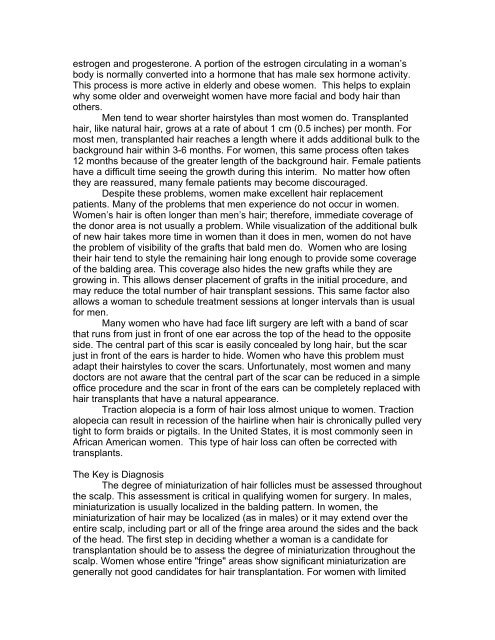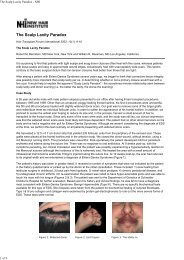The Patient's Guide to Hair Restoration - New Hair Institute
The Patient's Guide to Hair Restoration - New Hair Institute
The Patient's Guide to Hair Restoration - New Hair Institute
Create successful ePaper yourself
Turn your PDF publications into a flip-book with our unique Google optimized e-Paper software.
estrogen and progesterone. A portion of the estrogen circulating in a woman’s<br />
body is normally converted in<strong>to</strong> a hormone that has male sex hormone activity.<br />
This process is more active in elderly and obese women. This helps <strong>to</strong> explain<br />
why some older and overweight women have more facial and body hair than<br />
others.<br />
Men tend <strong>to</strong> wear shorter hairstyles than most women do. Transplanted<br />
hair, like natural hair, grows at a rate of about 1 cm (0.5 inches) per month. For<br />
most men, transplanted hair reaches a length where it adds additional bulk <strong>to</strong> the<br />
background hair within 3-6 months. For women, this same process often takes<br />
12 months because of the greater length of the background hair. Female patients<br />
have a difficult time seeing the growth during this interim. No matter how often<br />
they are reassured, many female patients may become discouraged.<br />
Despite these problems, women make excellent hair replacement<br />
patients. Many of the problems that men experience do not occur in women.<br />
Women’s hair is often longer than men’s hair; therefore, immediate coverage of<br />
the donor area is not usually a problem. While visualization of the additional bulk<br />
of new hair takes more time in women than it does in men, women do not have<br />
the problem of visibility of the grafts that bald men do. Women who are losing<br />
their hair tend <strong>to</strong> style the remaining hair long enough <strong>to</strong> provide some coverage<br />
of the balding area. This coverage also hides the new grafts while they are<br />
growing in. This allows denser placement of grafts in the initial procedure, and<br />
may reduce the <strong>to</strong>tal number of hair transplant sessions. This same fac<strong>to</strong>r also<br />
allows a woman <strong>to</strong> schedule treatment sessions at longer intervals than is usual<br />
for men.<br />
Many women who have had face lift surgery are left with a band of scar<br />
that runs from just in front of one ear across the <strong>to</strong>p of the head <strong>to</strong> the opposite<br />
side. <strong>The</strong> central part of this scar is easily concealed by long hair, but the scar<br />
just in front of the ears is harder <strong>to</strong> hide. Women who have this problem must<br />
adapt their hairstyles <strong>to</strong> cover the scars. Unfortunately, most women and many<br />
doc<strong>to</strong>rs are not aware that the central part of the scar can be reduced in a simple<br />
office procedure and the scar in front of the ears can be completely replaced with<br />
hair transplants that have a natural appearance.<br />
Traction alopecia is a form of hair loss almost unique <strong>to</strong> women. Traction<br />
alopecia can result in recession of the hairline when hair is chronically pulled very<br />
tight <strong>to</strong> form braids or pigtails. In the United States, it is most commonly seen in<br />
African American women. This type of hair loss can often be corrected with<br />
transplants.<br />
<strong>The</strong> Key is Diagnosis<br />
<strong>The</strong> degree of miniaturization of hair follicles must be assessed throughout<br />
the scalp. This assessment is critical in qualifying women for surgery. In males,<br />
miniaturization is usually localized in the balding pattern. In women, the<br />
miniaturization of hair may be localized (as in males) or it may extend over the<br />
entire scalp, including part or all of the fringe area around the sides and the back<br />
of the head. <strong>The</strong> first step in deciding whether a woman is a candidate for<br />
transplantation should be <strong>to</strong> assess the degree of miniaturization throughout the<br />
scalp. Women whose entire "fringe" areas show significant miniaturization are<br />
generally not good candidates for hair transplantation. For women with limited



